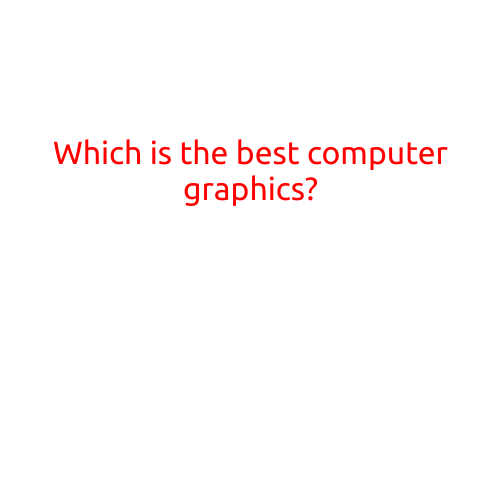
Which is the Best Computer Graphics? A Comprehensive Guide
In today’s digital age, computer graphics have become an integral part of our daily lives. From stunning visual effects in movies to realistic 3D models in video games, computer graphics have revolutionized the way we interact with digital content. But with so many types of computer graphics out there, which one is the best? In this article, we’ll delve into the world of computer graphics and explore the different types, their applications, and benefits to help you decide which one is the best for your needs.
1. 3D Computer Graphics
3D computer graphics, also known as 3D modeling, is the process of creating three-dimensional objects and environments using computer software. This type of computer graphics is commonly used in video games, movies, and animation. 3D models can be created using various techniques, such as polygon modeling, NURBS (non-uniform rational B-spline), and mesh editing.
Benefits: 3D computer graphics offer a high level of realism and detail, making them ideal for applications such as video games, movies, and architectural visualizations.
2. 2D Computer Graphics
2D computer graphics, also known as 2D digital artwork, is the process of creating two-dimensional graphics, such as images, logos, and animations. This type of computer graphics is commonly used in graphic design, multimedia, and web design.
Benefits: 2D computer graphics are versatile and can be easily incorporated into a wide range of applications, from print media to digital platforms.
3. CGI (Computer-Generated Imagery)
CGI is a type of computer graphics that involves the use of computer algorithms to generate images. This technique is commonly used in movies, TV shows, and video games.
Benefits: CGI allows for the creation of complex and realistic visual effects, making it ideal for applications such as film and television production.
4. CAD (Computer-Aided Design) Graphics
CAD graphics is a type of computer graphics used in engineering and architecture to create 2D and 3D designs. This type of computer graphics is commonly used in industries such as construction, automotive, and aerospace.
Benefits: CAD graphics allow for precise and accurate designs, making it ideal for applications such as product design and engineering.
5. Scientific Visualization Graphics
Scientific visualization graphics is a type of computer graphics used to represent complex scientific data in a visual format. This type of computer graphics is commonly used in fields such as medicine, astronomy, and environmental science.
Benefits: Scientific visualization graphics helps scientists and researchers to better understand complex data and make informed decisions.
6. Virtual Reality (VR) and Augmented Reality (AR) Graphics
VR and AR graphics are types of computer graphics that use real-time rendering to create immersive and interactive experiences. This type of computer graphics is commonly used in fields such as gaming, education, and healthcare.
Benefits: VR and AR graphics offer a unique and engaging way to experience digital content, making them ideal for applications such as gaming and education.
Conclusion
In conclusion, each type of computer graphics has its own unique benefits and applications. Whether you’re looking to create stunning visual effects for a movie, design a 3D model for a game, or visualize complex data for scientific research, there’s a type of computer graphics out there for you.
When choosing the best computer graphics for your needs, consider the following factors:
- Your level of expertise and experience
- The type of application or industry you’re working in
- The level of realism and detail required
- The software and hardware you have available
By considering these factors and understanding the different types of computer graphics, you’ll be able to make an informed decision and create stunning digital content that meets your needs.
References
- [1] CGI (Computer-Generated Imagery). (n.d.). Retrieved from https://en.wikipedia.org/wiki/Computer-generated_imagery
- [2] CAD (Computer-Aided Design) Graphics. (n.d.). Retrieved from https://en.wikipedia.org/wiki/Computer-aided_design
- [3] Scientific Visualization Graphics. (n.d.). Retrieved from https://en.wikipedia.org/wiki/Scientific_visualization
- [4] Virtual Reality (VR) and Augmented Reality (AR) Graphics. (n.d.). Retrieved from https://en.wikipedia.org/wiki/Virtual_reality





